秋招复习之栈与队列
前言
1 栈
「栈 stack」是一种遵循先入后出逻辑的线性数据结构。
我们可以将栈类比为桌面上的一摞盘子,如果想取出底部的盘子,则需要先将上面的盘子依次移走。我们将盘子替换为各种类型的元素(如整数、字符、对象等),就得到了栈这种数据结构。
如图所示,我们把堆叠元素的顶部称为“栈顶”,底部称为“栈底”。将把元素添加到栈顶的操作叫作“入栈”,删除栈顶元素的操作叫作“出栈”。


初始化栈
/* 初始化栈 */
Stack<Integer> stack = new Stack<>();
/* 元素入栈 */
stack.push(1);
stack.push(3);
stack.push(2);
stack.push(5);
stack.push(4);
/* 访问栈顶元素 */
int peek = stack.peek();
/* 元素出栈 */
int pop = stack.pop();
/* 获取栈的长度 */
int size = stack.size();
/* 判断是否为空 */
boolean isEmpty = stack.isEmpty();/* 初始化栈 */
stack<int> stack;
/* 元素入栈 */
stack.push(1);
stack.push(3);
stack.push(2);
stack.push(5);
stack.push(4);
/* 访问栈顶元素 */
int top = stack.top();
/* 元素出栈 */
stack.pop(); // 无返回值
/* 获取栈的长度 */
int size = stack.size();
/* 判断是否为空 */
bool empty = stack.empty();栈的实现
栈遵循先入后出的原则,因此我们只能在栈顶添加或删除元素。然而,数组和链表都可以在任意位置添加和删除元素,因此栈可以视为一种受限制的数组或链表。换句话说,我们可以“屏蔽”数组或链表的部分无关操作,使其对外表现的逻辑符合栈的特性。
基于链表的实现

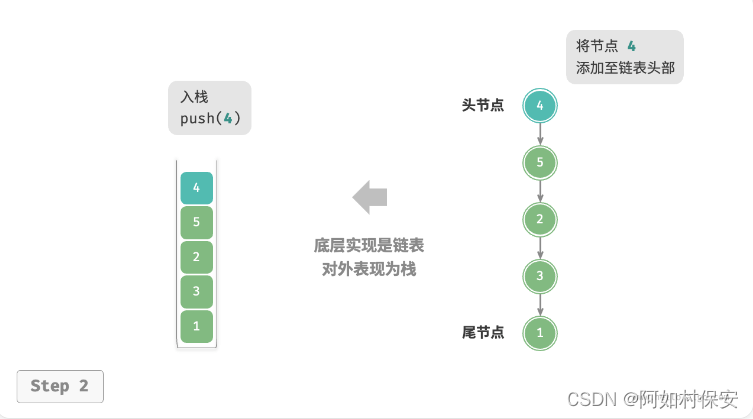
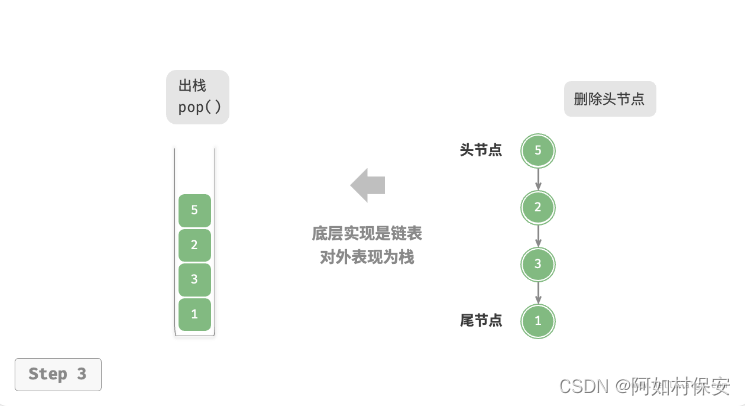
/* 基于链表实现的栈 */
class LinkedListStack {
private ListNode stackPeek; // 将头节点作为栈顶
private int stkSize = 0; // 栈的长度
public LinkedListStack() {
stackPeek = null;
}
/* 获取栈的长度 */
public int size() {
return stkSize;
}
/* 判断栈是否为空 */
public boolean isEmpty() {
return size() == 0;
}
/* 入栈 */
public void push(int num) {
ListNode node = new ListNode(num);
node.next = stackPeek;
stackPeek = node;
stkSize++;
}
/* 出栈 */
public int pop() {
int num = peek();
stackPeek = stackPeek.next;
stkSize--;
return num;
}
/* 访问栈顶元素 */
public int peek() {
if (isEmpty())
throw new IndexOutOfBoundsException();
return stackPeek.val;
}
/* 将 List 转化为 Array 并返回 */
public int[] toArray() {
ListNode node = stackPeek;
int[] res = new int[size()];
for (int i = res.length - 1; i >= 0; i--) {
res[i] = node.val;
node = node.next;
}
return res;
}
}/* 基于链表实现的栈 */
class LinkedListStack {
private:
ListNode *stackTop; // 将头节点作为栈顶
int stkSize; // 栈的长度
public:
LinkedListStack() {
stackTop = nullptr;
stkSize = 0;
}
~LinkedListStack() {
// 遍历链表删除节点,释放内存
freeMemoryLinkedList(stackTop);
}
/* 获取栈的长度 */
int size() {
return stkSize;
}
/* 判断栈是否为空 */
bool isEmpty() {
return size() == 0;
}
/* 入栈 */
void push(int num) {
ListNode *node = new ListNode(num);
node->next = stackTop;
stackTop = node;
stkSize++;
}
/* 出栈 */
int pop() {
int num = top();
ListNode *tmp = stackTop;
stackTop = stackTop->next;
// 释放内存
delete tmp;
stkSize--;
return num;
}
/* 访问栈顶元素 */
int top() {
if (isEmpty())
throw out_of_range("栈为空");
return stackTop->val;
}
/* 将 List 转化为 Array 并返回 */
vector<int> toVector() {
ListNode *node = stackTop;
vector<int> res(size());
for (int i = res.size() - 1; i >= 0; i--) {
res[i] = node->val;
node = node->next;
}
return res;
}
};基于数组的实现
使用数组实现栈时,我们可以将数组的尾部作为栈顶。如图 5-3 所示,入栈与出栈操作分别对应在数组尾部添加元素与删除元素,时间复杂度都为O(1)?。
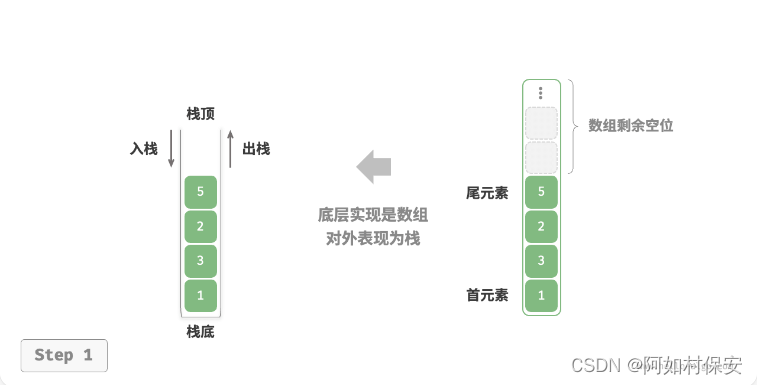
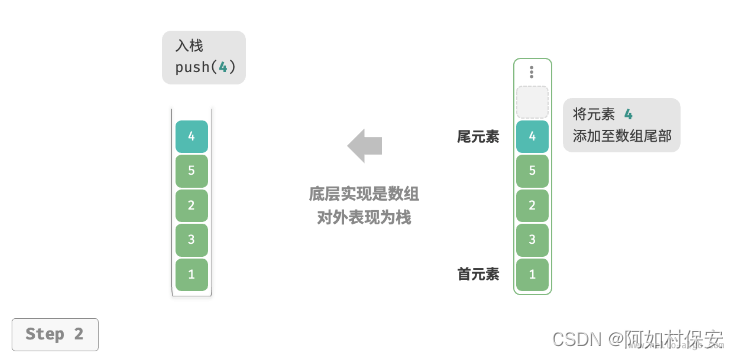
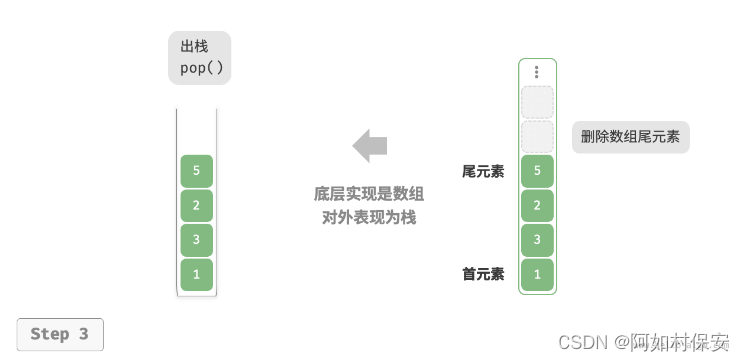
使用动态数组
/* 基于数组实现的栈 */
class ArrayStack {
private ArrayList<Integer> stack;
public ArrayStack() {
// 初始化列表(动态数组)
stack = new ArrayList<>();
}
/* 获取栈的长度 */
public int size() {
return stack.size();
}
/* 判断栈是否为空 */
public boolean isEmpty() {
return size() == 0;
}
/* 入栈 */
public void push(int num) {
stack.add(num);
}
/* 出栈 */
public int pop() {
if (isEmpty())
throw new IndexOutOfBoundsException();
return stack.remove(size() - 1);
}
/* 访问栈顶元素 */
public int peek() {
if (isEmpty())
throw new IndexOutOfBoundsException();
return stack.get(size() - 1);
}
/* 将 List 转化为 Array 并返回 */
public Object[] toArray() {
return stack.toArray();
}
}/* 基于数组实现的栈 */
class ArrayStack {
private:
vector<int> stack;
public:
/* 获取栈的长度 */
int size() {
return stack.size();
}
/* 判断栈是否为空 */
bool isEmpty() {
return stack.size() == 0;
}
/* 入栈 */
void push(int num) {
stack.push_back(num);
}
/* 出栈 */
int pop() {
int num = top();
stack.pop_back();
return num;
}
/* 访问栈顶元素 */
int top() {
if (isEmpty())
throw out_of_range("栈为空");
return stack.back();
}
/* 返回 Vector */
vector<int> toVector() {
return stack;
}
};两种实现对比
支持操作
两种实现都支持栈定义中的各项操作。数组实现额外支持随机访问,但这已超出了栈的定义范畴,因此一般不会用到。
时间效率
在基于数组的实现中,入栈和出栈操作都在预先分配好的连续内存中进行,具有很好的缓存本地性,因此效率较高。然而,如果入栈时超出数组容量,会触发扩容机制,导致该次入栈操作的时间复杂度变为?O(n)?。
在基于链表的实现中,链表的扩容非常灵活,不存在上述数组扩容时效率降低的问题。但是,入栈操作需要初始化节点对象并修改指针,因此效率相对较低。不过,如果入栈元素本身就是节点对象,那么可以省去初始化步骤,从而提高效率。
综上所述,当入栈与出栈操作的元素是基本数据类型时,例如?int?或?double?,我们可以得出以下结论。
- 基于数组实现的栈在触发扩容时效率会降低,但由于扩容是低频操作,因此平均效率更高。
- 基于链表实现的栈可以提供更加稳定的效率表现。
空间效率
在初始化列表时,系统会为列表分配“初始容量”,该容量可能超出实际需求;并且,扩容机制通常是按照特定倍率(例如 2 倍)进行扩容的,扩容后的容量也可能超出实际需求。因此,基于数组实现的栈可能造成一定的空间浪费。
然而,由于链表节点需要额外存储指针,因此链表节点占用的空间相对较大。
综上,我们不能简单地确定哪种实现更加节省内存,需要针对具体情况进行分析。
2?队列
「队列 queue」是一种遵循先入先出规则的线性数据结构。顾名思义,队列模拟了排队现象,即新来的人不断加入队列尾部,而位于队列头部的人逐个离开。
如图所示,我们将队列头部称为“队首”,尾部称为“队尾”,将把元素加入队尾的操作称为“入队”,删除队首元素的操作称为“出队”。

队列的基本操作?
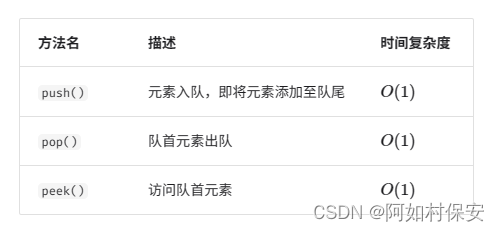
?
/* 初始化队列 */
Queue<Integer> queue = new LinkedList<>();
/* 元素入队 */
queue.offer(1);
queue.offer(3);
queue.offer(2);
queue.offer(5);
queue.offer(4);
/* 访问队首元素 */
int peek = queue.peek();
/* 元素出队 */
int pop = queue.poll();
/* 获取队列的长度 */
int size = queue.size();
/* 判断队列是否为空 */
boolean isEmpty = queue.isEmpty();/* 初始化队列 */
queue<int> queue;
/* 元素入队 */
queue.push(1);
queue.push(3);
queue.push(2);
queue.push(5);
queue.push(4);
/* 访问队首元素 */
int front = queue.front();
/* 元素出队 */
queue.pop();
/* 获取队列的长度 */
int size = queue.size();
/* 判断队列是否为空 */
bool empty = queue.empty();队列的实现
为了实现队列,我们需要一种数据结构,可以在一端添加元素,并在另一端删除元素,链表和数组都符合要求。
基于链表的实现
我们可以将链表的“头节点”和“尾节点”分别视为“队首”和“队尾”,规定队尾仅可添加节点,队首仅可删除节点。



/* 基于链表实现的队列 */
class LinkedListQueue {
private ListNode front, rear; // 头节点 front ,尾节点 rear
private int queSize = 0;
public LinkedListQueue() {
front = null;
rear = null;
}
/* 获取队列的长度 */
public int size() {
return queSize;
}
/* 判断队列是否为空 */
public boolean isEmpty() {
return size() == 0;
}
/* 入队 */
public void push(int num) {
// 在尾节点后添加 num
ListNode node = new ListNode(num);
// 如果队列为空,则令头、尾节点都指向该节点
if (front == null) {
front = node;
rear = node;
// 如果队列不为空,则将该节点添加到尾节点后
} else {
rear.next = node;
rear = node;
}
queSize++;
}
/* 出队 */
public int pop() {
int num = peek();
// 删除头节点
front = front.next;
queSize--;
return num;
}
/* 访问队首元素 */
public int peek() {
if (isEmpty())
throw new IndexOutOfBoundsException();
return front.val;
}
/* 将链表转化为 Array 并返回 */
public int[] toArray() {
ListNode node = front;
int[] res = new int[size()];
for (int i = 0; i < res.length; i++) {
res[i] = node.val;
node = node.next;
}
return res;
}
}/* 基于链表实现的队列 */
class LinkedListQueue {
private:
ListNode *front, *rear; // 头节点 front ,尾节点 rear
int queSize;
public:
LinkedListQueue() {
front = nullptr;
rear = nullptr;
queSize = 0;
}
~LinkedListQueue() {
// 遍历链表删除节点,释放内存
freeMemoryLinkedList(front);
}
/* 获取队列的长度 */
int size() {
return queSize;
}
/* 判断队列是否为空 */
bool isEmpty() {
return queSize == 0;
}
/* 入队 */
void push(int num) {
// 在尾节点后添加 num
ListNode *node = new ListNode(num);
// 如果队列为空,则令头、尾节点都指向该节点
if (front == nullptr) {
front = node;
rear = node;
}
// 如果队列不为空,则将该节点添加到尾节点后
else {
rear->next = node;
rear = node;
}
queSize++;
}
/* 出队 */
int pop() {
int num = peek();
// 删除头节点
ListNode *tmp = front;
front = front->next;
// 释放内存
delete tmp;
queSize--;
return num;
}
/* 访问队首元素 */
int peek() {
if (size() == 0)
throw out_of_range("队列为空");
return front->val;
}
/* 将链表转化为 Vector 并返回 */
vector<int> toVector() {
ListNode *node = front;
vector<int> res(size());
for (int i = 0; i < res.size(); i++) {
res[i] = node->val;
node = node->next;
}
return res;
}
};基于数组的实现
在数组中删除首元素的时间复杂度为?O(n)?,这会导致出队操作效率较低。然而,我们可以采用以下巧妙方法来避免这个问题。
我们可以使用一个变量?front?指向队首元素的索引,并维护一个变量?size?用于记录队列长度。定义?rear = front + size?,这个公式计算出的?rear?指向队尾元素之后的下一个位置。
基于此设计,数组中包含元素的有效区间为?[front, rear - 1],各种操作的实现方法如图。
- 入队操作:将输入元素赋值给?
rear?索引处,并将?size?增加 1 。 - 出队操作:只需将?
front?增加 1 ,并将?size?减少 1 。
可以看到,入队和出队操作都只需进行一次操作,时间复杂度均为?O(1)?。

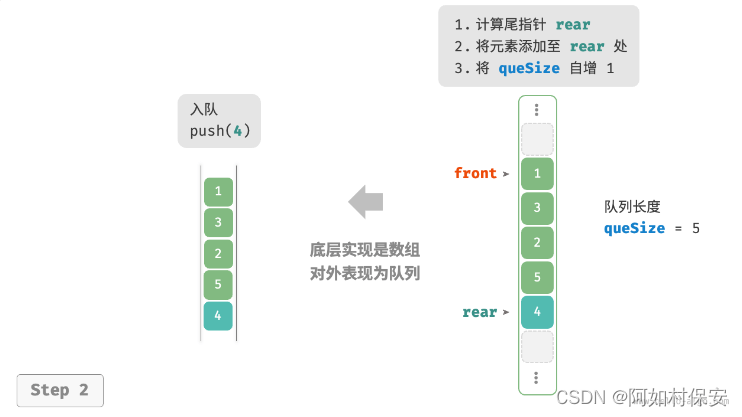
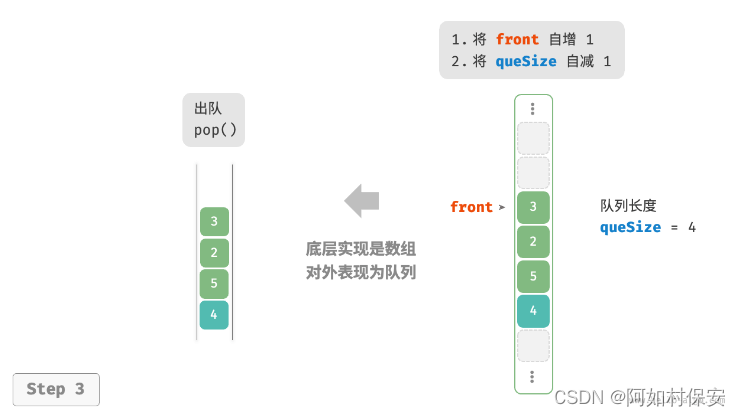
你可能会发现一个问题:在不断进行入队和出队的过程中,front?和?rear?都在向右移动,当它们到达数组尾部时就无法继续移动了。为了解决此问题,我们可以将数组视为首尾相接的“环形数组”。
对于环形数组,我们需要让?front?或?rear?在越过数组尾部时,直接回到数组头部继续遍历。这种周期性规律可以通过“取余操作”来实现,代码如下所示:
/* 基于环形数组实现的队列 */
class ArrayQueue {
private int[] nums; // 用于存储队列元素的数组
private int front; // 队首指针,指向队首元素
private int queSize; // 队列长度
public ArrayQueue(int capacity) {
nums = new int[capacity];
front = queSize = 0;
}
/* 获取队列的容量 */
public int capacity() {
return nums.length;
}
/* 获取队列的长度 */
public int size() {
return queSize;
}
/* 判断队列是否为空 */
public boolean isEmpty() {
return queSize == 0;
}
/* 入队 */
public void push(int num) {
if (queSize == capacity()) {
System.out.println("队列已满");
return;
}
// 计算队尾指针,指向队尾索引 + 1
// 通过取余操作实现 rear 越过数组尾部后回到头部
int rear = (front + queSize) % capacity();
// 将 num 添加至队尾
nums[rear] = num;
queSize++;
}
/* 出队 */
public int pop() {
int num = peek();
// 队首指针向后移动一位,若越过尾部,则返回到数组头部
front = (front + 1) % capacity();
queSize--;
return num;
}
/* 访问队首元素 */
public int peek() {
if (isEmpty())
throw new IndexOutOfBoundsException();
return nums[front];
}
/* 返回数组 */
public int[] toArray() {
// 仅转换有效长度范围内的列表元素
int[] res = new int[queSize];
for (int i = 0, j = front; i < queSize; i++, j++) {
res[i] = nums[j % capacity()];
}
return res;
}
}/* 基于环形数组实现的队列 */
class ArrayQueue {
private:
int *nums; // 用于存储队列元素的数组
int front; // 队首指针,指向队首元素
int queSize; // 队列长度
int queCapacity; // 队列容量
public:
ArrayQueue(int capacity) {
// 初始化数组
nums = new int[capacity];
queCapacity = capacity;
front = queSize = 0;
}
~ArrayQueue() {
delete[] nums;
}
/* 获取队列的容量 */
int capacity() {
return queCapacity;
}
/* 获取队列的长度 */
int size() {
return queSize;
}
/* 判断队列是否为空 */
bool isEmpty() {
return size() == 0;
}
/* 入队 */
void push(int num) {
if (queSize == queCapacity) {
cout << "队列已满" << endl;
return;
}
// 计算队尾指针,指向队尾索引 + 1
// 通过取余操作实现 rear 越过数组尾部后回到头部
int rear = (front + queSize) % queCapacity;
// 将 num 添加至队尾
nums[rear] = num;
queSize++;
}
/* 出队 */
int pop() {
int num = peek();
// 队首指针向后移动一位,若越过尾部,则返回到数组头部
front = (front + 1) % queCapacity;
queSize--;
return num;
}
/* 访问队首元素 */
int peek() {
if (isEmpty())
throw out_of_range("队列为空");
return nums[front];
}
/* 将数组转化为 Vector 并返回 */
vector<int> toVector() {
// 仅转换有效长度范围内的列表元素
vector<int> arr(queSize);
for (int i = 0, j = front; i < queSize; i++, j++) {
arr[i] = nums[j % queCapacity];
}
return arr;
}
};以上实现的队列仍然具有局限性:其长度不可变。然而,这个问题不难解决,我们可以将数组替换为动态数组,从而引入扩容机制。
3?双向队列
在队列中,我们仅能删除头部元素或在尾部添加元素。如图所示,「双向队列 double-ended queue」提供了更高的灵活性,允许在头部和尾部执行元素的添加或删除操作。
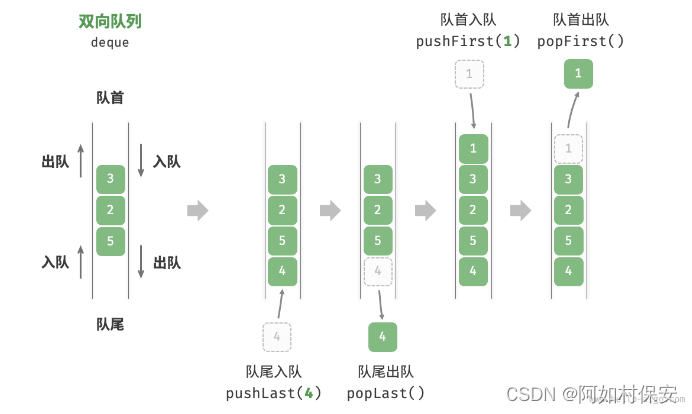 双向队列常用操作
双向队列常用操作
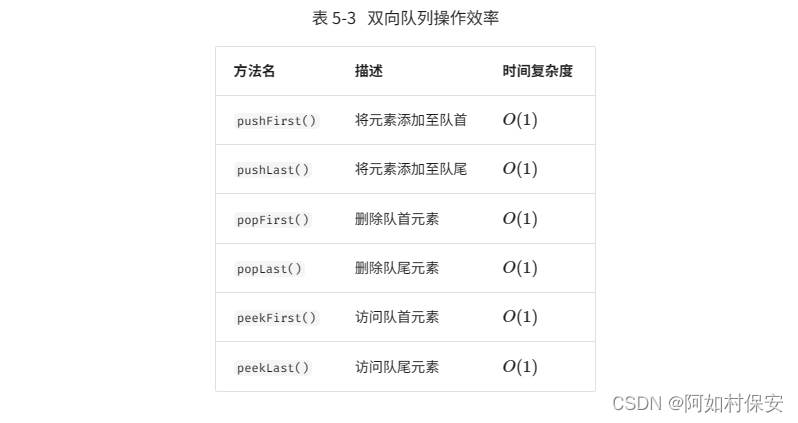
/* 初始化双向队列 */
Deque<Integer> deque = new LinkedList<>();
/* 元素入队 */
deque.offerLast(2); // 添加至队尾
deque.offerLast(5);
deque.offerLast(4);
deque.offerFirst(3); // 添加至队首
deque.offerFirst(1);
/* 访问元素 */
int peekFirst = deque.peekFirst(); // 队首元素
int peekLast = deque.peekLast(); // 队尾元素
/* 元素出队 */
int popFirst = deque.pollFirst(); // 队首元素出队
int popLast = deque.pollLast(); // 队尾元素出队
/* 获取双向队列的长度 */
int size = deque.size();
/* 判断双向队列是否为空 */
boolean isEmpty = deque.isEmpty();/* 初始化双向队列 */
deque<int> deque;
/* 元素入队 */
deque.push_back(2); // 添加至队尾
deque.push_back(5);
deque.push_back(4);
deque.push_front(3); // 添加至队首
deque.push_front(1);
/* 访问元素 */
int front = deque.front(); // 队首元素
int back = deque.back(); // 队尾元素
/* 元素出队 */
deque.pop_front(); // 队首元素出队
deque.pop_back(); // 队尾元素出队
/* 获取双向队列的长度 */
int size = deque.size();
/* 判断双向队列是否为空 */
bool empty = deque.empty();双向队列实现
基于双向链表的实现
使用普通单向链表来实现队列,因为它可以方便地删除头节点(对应出队操作)和在尾节点后添加新节点(对应入队操作)。
对于双向队列而言,头部和尾部都可以执行入队和出队操作。换句话说,双向队列需要实现另一个对称方向的操作。为此,我们采用“双向链表”作为双向队列的底层数据结构。
如图所示,我们将双向链表的头节点和尾节点视为双向队列的队首和队尾,同时实现在两端添加和删除节点的功能。
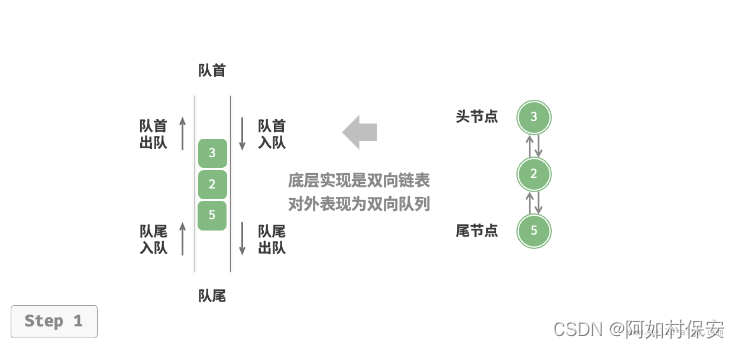

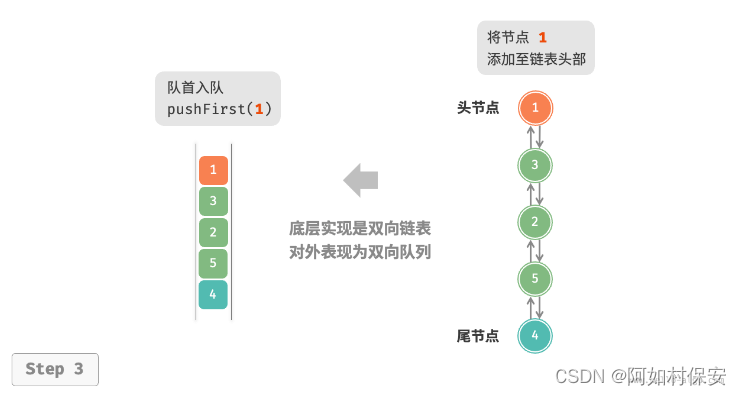


/* 双向链表节点 */
class ListNode {
int val; // 节点值
ListNode next; // 后继节点引用
ListNode prev; // 前驱节点引用
ListNode(int val) {
this.val = val;
prev = next = null;
}
}
/* 基于双向链表实现的双向队列 */
class LinkedListDeque {
private ListNode front, rear; // 头节点 front ,尾节点 rear
private int queSize = 0; // 双向队列的长度
public LinkedListDeque() {
front = rear = null;
}
/* 获取双向队列的长度 */
public int size() {
return queSize;
}
/* 判断双向队列是否为空 */
public boolean isEmpty() {
return size() == 0;
}
/* 入队操作 */
private void push(int num, boolean isFront) {
ListNode node = new ListNode(num);
// 若链表为空,则令 front 和 rear 都指向 node
if (isEmpty())
front = rear = node;
// 队首入队操作
else if (isFront) {
// 将 node 添加至链表头部
front.prev = node;
node.next = front;
front = node; // 更新头节点
// 队尾入队操作
} else {
// 将 node 添加至链表尾部
rear.next = node;
node.prev = rear;
rear = node; // 更新尾节点
}
queSize++; // 更新队列长度
}
/* 队首入队 */
public void pushFirst(int num) {
push(num, true);
}
/* 队尾入队 */
public void pushLast(int num) {
push(num, false);
}
/* 出队操作 */
private int pop(boolean isFront) {
if (isEmpty())
throw new IndexOutOfBoundsException();
int val;
// 队首出队操作
if (isFront) {
val = front.val; // 暂存头节点值
// 删除头节点
ListNode fNext = front.next;
if (fNext != null) {
fNext.prev = null;
front.next = null;
}
front = fNext; // 更新头节点
// 队尾出队操作
} else {
val = rear.val; // 暂存尾节点值
// 删除尾节点
ListNode rPrev = rear.prev;
if (rPrev != null) {
rPrev.next = null;
rear.prev = null;
}
rear = rPrev; // 更新尾节点
}
queSize--; // 更新队列长度
return val;
}
/* 队首出队 */
public int popFirst() {
return pop(true);
}
/* 队尾出队 */
public int popLast() {
return pop(false);
}
/* 访问队首元素 */
public int peekFirst() {
if (isEmpty())
throw new IndexOutOfBoundsException();
return front.val;
}
/* 访问队尾元素 */
public int peekLast() {
if (isEmpty())
throw new IndexOutOfBoundsException();
return rear.val;
}
/* 返回数组用于打印 */
public int[] toArray() {
ListNode node = front;
int[] res = new int[size()];
for (int i = 0; i < res.length; i++) {
res[i] = node.val;
node = node.next;
}
return res;
}
}/* 双向链表节点 */
struct DoublyListNode {
int val; // 节点值
DoublyListNode *next; // 后继节点指针
DoublyListNode *prev; // 前驱节点指针
DoublyListNode(int val) : val(val), prev(nullptr), next(nullptr) {
}
};
/* 基于双向链表实现的双向队列 */
class LinkedListDeque {
private:
DoublyListNode *front, *rear; // 头节点 front ,尾节点 rear
int queSize = 0; // 双向队列的长度
public:
/* 构造方法 */
LinkedListDeque() : front(nullptr), rear(nullptr) {
}
/* 析构方法 */
~LinkedListDeque() {
// 遍历链表删除节点,释放内存
DoublyListNode *pre, *cur = front;
while (cur != nullptr) {
pre = cur;
cur = cur->next;
delete pre;
}
}
/* 获取双向队列的长度 */
int size() {
return queSize;
}
/* 判断双向队列是否为空 */
bool isEmpty() {
return size() == 0;
}
/* 入队操作 */
void push(int num, bool isFront) {
DoublyListNode *node = new DoublyListNode(num);
// 若链表为空,则令 front 和 rear 都指向 node
if (isEmpty())
front = rear = node;
// 队首入队操作
else if (isFront) {
// 将 node 添加至链表头部
front->prev = node;
node->next = front;
front = node; // 更新头节点
// 队尾入队操作
} else {
// 将 node 添加至链表尾部
rear->next = node;
node->prev = rear;
rear = node; // 更新尾节点
}
queSize++; // 更新队列长度
}
/* 队首入队 */
void pushFirst(int num) {
push(num, true);
}
/* 队尾入队 */
void pushLast(int num) {
push(num, false);
}
/* 出队操作 */
int pop(bool isFront) {
if (isEmpty())
throw out_of_range("队列为空");
int val;
// 队首出队操作
if (isFront) {
val = front->val; // 暂存头节点值
// 删除头节点
DoublyListNode *fNext = front->next;
if (fNext != nullptr) {
fNext->prev = nullptr;
front->next = nullptr;
delete front;
}
front = fNext; // 更新头节点
// 队尾出队操作
} else {
val = rear->val; // 暂存尾节点值
// 删除尾节点
DoublyListNode *rPrev = rear->prev;
if (rPrev != nullptr) {
rPrev->next = nullptr;
rear->prev = nullptr;
delete rear;
}
rear = rPrev; // 更新尾节点
}
queSize--; // 更新队列长度
return val;
}
/* 队首出队 */
int popFirst() {
return pop(true);
}
/* 队尾出队 */
int popLast() {
return pop(false);
}
/* 访问队首元素 */
int peekFirst() {
if (isEmpty())
throw out_of_range("双向队列为空");
return front->val;
}
/* 访问队尾元素 */
int peekLast() {
if (isEmpty())
throw out_of_range("双向队列为空");
return rear->val;
}
/* 返回数组用于打印 */
vector<int> toVector() {
DoublyListNode *node = front;
vector<int> res(size());
for (int i = 0; i < res.size(); i++) {
res[i] = node->val;
node = node->next;
}
return res;
}
};基于数组的实现
与基于数组实现队列类似,我们也可以使用环形数组来实现双向队列。



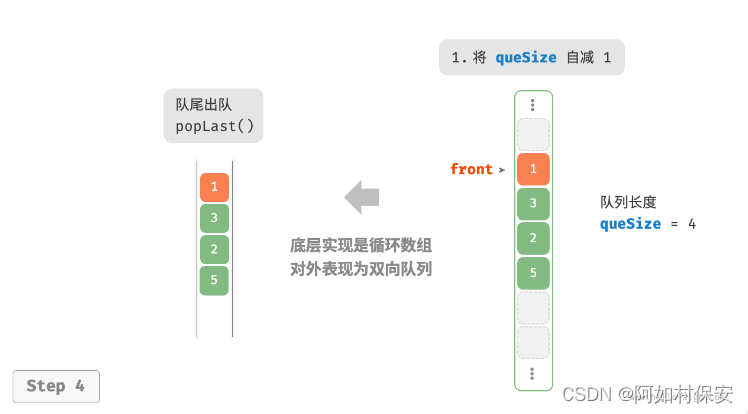
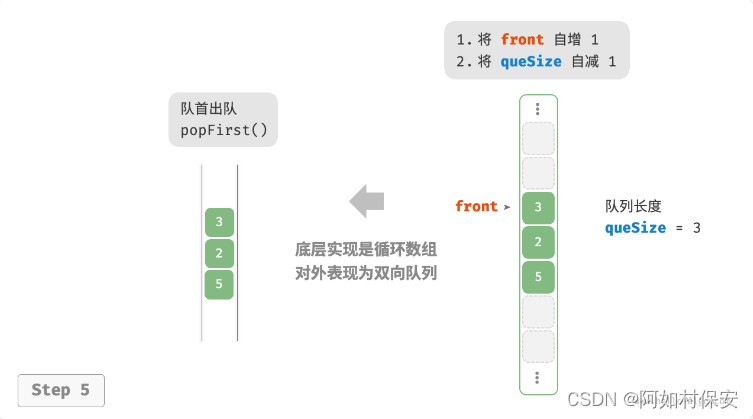
在队列的实现基础上,仅需增加“队首入队”和“队尾出队”的方法:
/* 基于环形数组实现的双向队列 */
class ArrayDeque {
private int[] nums; // 用于存储双向队列元素的数组
private int front; // 队首指针,指向队首元素
private int queSize; // 双向队列长度
/* 构造方法 */
public ArrayDeque(int capacity) {
this.nums = new int[capacity];
front = queSize = 0;
}
/* 获取双向队列的容量 */
public int capacity() {
return nums.length;
}
/* 获取双向队列的长度 */
public int size() {
return queSize;
}
/* 判断双向队列是否为空 */
public boolean isEmpty() {
return queSize == 0;
}
/* 计算环形数组索引 */
private int index(int i) {
// 通过取余操作实现数组首尾相连
// 当 i 越过数组尾部后,回到头部
// 当 i 越过数组头部后,回到尾部
return (i + capacity()) % capacity();
}
/* 队首入队 */
public void pushFirst(int num) {
if (queSize == capacity()) {
System.out.println("双向队列已满");
return;
}
// 队首指针向左移动一位
// 通过取余操作实现 front 越过数组头部后回到尾部
front = index(front - 1);
// 将 num 添加至队首
nums[front] = num;
queSize++;
}
/* 队尾入队 */
public void pushLast(int num) {
if (queSize == capacity()) {
System.out.println("双向队列已满");
return;
}
// 计算队尾指针,指向队尾索引 + 1
int rear = index(front + queSize);
// 将 num 添加至队尾
nums[rear] = num;
queSize++;
}
/* 队首出队 */
public int popFirst() {
int num = peekFirst();
// 队首指针向后移动一位
front = index(front + 1);
queSize--;
return num;
}
/* 队尾出队 */
public int popLast() {
int num = peekLast();
queSize--;
return num;
}
/* 访问队首元素 */
public int peekFirst() {
if (isEmpty())
throw new IndexOutOfBoundsException();
return nums[front];
}
/* 访问队尾元素 */
public int peekLast() {
if (isEmpty())
throw new IndexOutOfBoundsException();
// 计算尾元素索引
int last = index(front + queSize - 1);
return nums[last];
}
/* 返回数组用于打印 */
public int[] toArray() {
// 仅转换有效长度范围内的列表元素
int[] res = new int[queSize];
for (int i = 0, j = front; i < queSize; i++, j++) {
res[i] = nums[index(j)];
}
return res;
}
}/* 基于环形数组实现的双向队列 */
class ArrayDeque {
private:
vector<int> nums; // 用于存储双向队列元素的数组
int front; // 队首指针,指向队首元素
int queSize; // 双向队列长度
public:
/* 构造方法 */
ArrayDeque(int capacity) {
nums.resize(capacity);
front = queSize = 0;
}
/* 获取双向队列的容量 */
int capacity() {
return nums.size();
}
/* 获取双向队列的长度 */
int size() {
return queSize;
}
/* 判断双向队列是否为空 */
bool isEmpty() {
return queSize == 0;
}
/* 计算环形数组索引 */
int index(int i) {
// 通过取余操作实现数组首尾相连
// 当 i 越过数组尾部后,回到头部
// 当 i 越过数组头部后,回到尾部
return (i + capacity()) % capacity();
}
/* 队首入队 */
void pushFirst(int num) {
if (queSize == capacity()) {
cout << "双向队列已满" << endl;
return;
}
// 队首指针向左移动一位
// 通过取余操作实现 front 越过数组头部后回到尾部
front = index(front - 1);
// 将 num 添加至队首
nums[front] = num;
queSize++;
}
/* 队尾入队 */
void pushLast(int num) {
if (queSize == capacity()) {
cout << "双向队列已满" << endl;
return;
}
// 计算队尾指针,指向队尾索引 + 1
int rear = index(front + queSize);
// 将 num 添加至队尾
nums[rear] = num;
queSize++;
}
/* 队首出队 */
int popFirst() {
int num = peekFirst();
// 队首指针向后移动一位
front = index(front + 1);
queSize--;
return num;
}
/* 队尾出队 */
int popLast() {
int num = peekLast();
queSize--;
return num;
}
/* 访问队首元素 */
int peekFirst() {
if (isEmpty())
throw out_of_range("双向队列为空");
return nums[front];
}
/* 访问队尾元素 */
int peekLast() {
if (isEmpty())
throw out_of_range("双向队列为空");
// 计算尾元素索引
int last = index(front + queSize - 1);
return nums[last];
}
/* 返回数组用于打印 */
vector<int> toVector() {
// 仅转换有效长度范围内的列表元素
vector<int> res(queSize);
for (int i = 0, j = front; i < queSize; i++, j++) {
res[i] = nums[index(j)];
}
return res;
}
};总结
- 栈是一种遵循先入后出原则的数据结构,可通过数组或链表来实现。
- 在时间效率方面,栈的数组实现具有较高的平均效率,但在扩容过程中,单次入栈操作的时间复杂度会劣化至?�(�)?。相比之下,栈的链表实现具有更为稳定的效率表现。
- 在空间效率方面,栈的数组实现可能导致一定程度的空间浪费。但需要注意的是,链表节点所占用的内存空间比数组元素更大。
- 队列是一种遵循先入先出原则的数据结构,同样可以通过数组或链表来实现。在时间效率和空间效率的对比上,队列的结论与前述栈的结论相似。
- 双向队列是一种具有更高自由度的队列,它允许在两端进行元素的添加和删除操作。
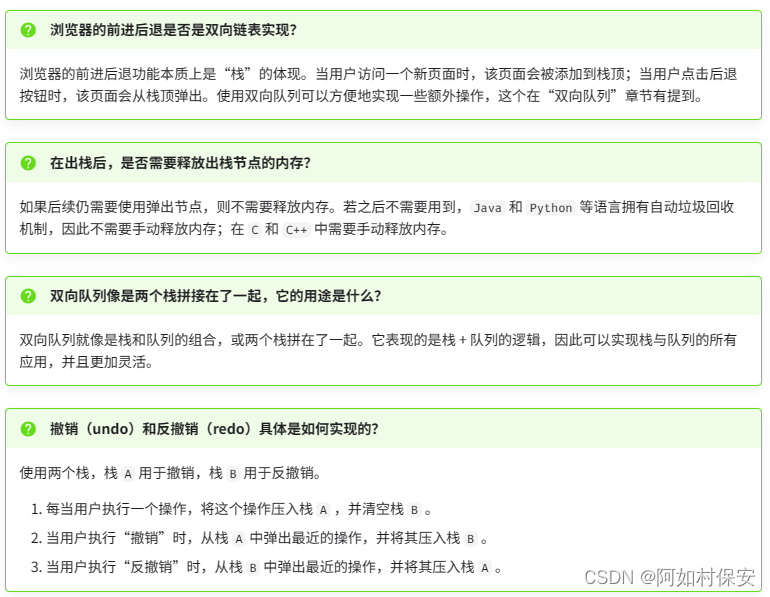
啊加油,我可以的!
本文来自互联网用户投稿,该文观点仅代表作者本人,不代表本站立场。本站仅提供信息存储空间服务,不拥有所有权,不承担相关法律责任。 如若内容造成侵权/违法违规/事实不符,请联系我的编程经验分享网邮箱:chenni525@qq.com进行投诉反馈,一经查实,立即删除!
- Python教程
- 深入理解 MySQL 中的 HAVING 关键字和聚合函数
- Qt之QChar编码(1)
- MyBatis入门基础篇
- 用Python脚本实现FFmpeg批量转换
- 程序员必知!命令模式的实战应用与案例分析
- 【高效视频处理】BMF 项目安装与老视频修复体验全流程及总结
- ESP32S3+HX8347+3线SPI运行LVGL例程
- 好的软件测试人员简历是什么样子的?
- SS&C | Blue Prism报告:2024年智能自动化(IA)7大趋势预测
- Python进阶学习:像RANK一样学Python
- 获取地图上两点间距离
- linux 操作系统中出现 /usr/bin/ld: 找不到 -lstdc++
- javacv工具类
- Vue 官方周报 #125 - 强制重新渲染Vue组件的最佳方法